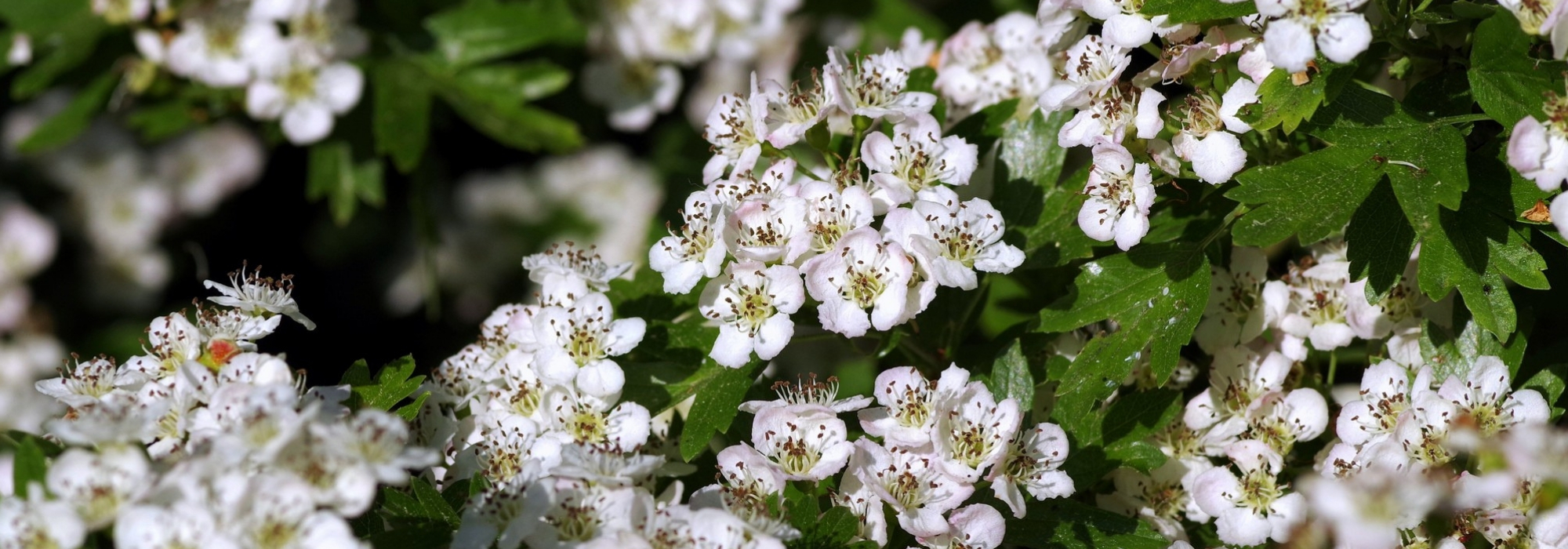
Hawthorn, Crataegus: planting, pruning, care
Contents
Hawthorn in a nutshell
- Hawthorn is a small tree or large bush, very hardy and resilient, that copes with most soils and situations.
- They flower in May and produce edible fruits in September.
- In the garden, they can be used as a clipped hedge, an informal hedge or planted alone as a small ornamental tree.
- True wildlife oases, hawthorns provide shelter and food for insects, birds and small mammals.
- There are many varieties, some with double flowers that are very decorative.
A word from our expert
Hawthorn, or rather hawthorns – because there are very many species – of the genus Crataegus are small trees or large deciduous bushes that are particularly hardy. Our two native species are Crataegus laevigata and Crataegus monogyna. These are, moreover, the two main species found in commerce.
Even if they do not much like growing in dense shade, they tolerate all other situations and all types of soil, even the heaviest clay. If you add to that unrivalled hardiness, hawthorns rank among the easiest small flowering trees to succeed with in the garden.
Their scented white or pink flowering in May is a delight for bees. Meanwhile, their haws, the small fruits, please birds and small mammals. The tangled mass of thorny branches provides a secure refuge for all garden wildlife.
It is also a medicinal plant known since Antiquity, with countless legends and local tales woven through literature and popular imagination.
In a natural garden, as part of a loose, slightly wild or defensive hedge, or simply as a charming small ornamental tree in a bed of bushes alongside other flowering bushes (ornamental crab apple, potentilla or black elder) : hawthorn is clearly indispensable to (re)plant in our gardens! So consider giving it a little space…
Description and botany of Hawthorn - Crataegus
Botanical data
- Latin name Crataegus spp.
- Family Rosaceae
- Common name Hawthorn, Whitethorn, May-tree, May
- Flowering May-June
- Height 2 m to 8 m
- Exposure sun or partial shade
- Soil type ordinary, even poor, calcareous or clay
- Hardiness -15°C
Native to the whole Northern Hemisphere (North America, Asia, Europe and even North Africa), hawthorns belong to family Rosaceae. Genus Crataegus includes more than a hundred different species, not counting hybrids and subspecies. Here are some examples you might encounter at nurseries: Crataegus azarolus, Crataegus brachyacantha, Crataegus chrysocarpa, Crataegus coccinea, Crataegus cuneata, Crataegus crus-galli (known as “cockspur thorn”), Crataegus douglasii, Crataegus flava, Crataegus lavalleei, Crataegus mollis, Crataegus phaenopyrum, Crataegus pinnatifida, Crataegus wattiana, … But it is above all our two native hawthorns that are most frequently encountered: Crataegus monogyna and Crataegus laevigata.
All are small trees or bushy bushes with deciduous foliage growing on a single trunk. In European species, leaves are alternate and deeply lobed, with 3 to 9 lobes, whereas in American and Asian taxa leaves are simple and ovate. Bark is grey, channelled and rough.
They are also thorny and strongly ramified bushes, ideal for defensive hedges and for sheltering birds during nesting period and small mammals year-round.
Flowers, white, pink or red depending on species or cultivar, with five petals, open in May and are grouped in corymbs. Stamens are red. Flowers are scented and very melliferous. Depending on cultivar, flowers can be single, semi-double or double (as with ‘Paul’s Scarlet’, for example).

Crataegus laevigata – botanical illustration
This is followed in September by fruiting in red, yellow or blue, edible for animals and gardener. Although somewhat bland in flavour, haws are pleasant in jam when mixed with other fruits (see ‘recipe’ section below).
Carl von Linné did not distinguish between our two native hawthorns: Crataegus monogyna or common hawthorn, found throughout France and Belgium, and Crataegus laevigata or whitethorn, found rather in southern France and up to North Africa, and grouped them simply under name Crataegus oxyacantha from Latin ‘Oxus’ meaning ‘acute’ and ‘Acantha’ meaning ‘thorn’. It is true that from a simple observation of leaves these two hawthorns are almost impossible to tell apart (hybridization between them occurs). The two species are however clearly different in regard to their flowers, one style for C. monogyna and two styles for C. laevigata, and their haws, a drupe (fruit with a single large seed) in C. monogyna and a berry (fruits with many small seeds) in C. laevigata. Do not be surprised to find name C. oxyacantha in older works.
Sexual maturity, and thus first flowering, is reached at around five to six years of cultivation. With fairly slow growth, lifespan can exceed five hundred years. Nowadays it is not uncommon to encounter a very old hawthorn in European villages. Since antiquity, hawthorn has been revered and used for its fruit, flowers and leaves in medicinal applications, notably as a cardiac regulator and to lower blood pressure. Numerous beliefs, legends and local stories about it populate literature and collective imagination.
Plant hawthorns in garden as a formal clipped hedge or an informal hedge: both become virtually impenetrable with age. They can also be planted as specimens or among other shrubs in a border.
Hawthorns are small, very hardy and resilient trees that grow in sun or partial shade and tolerate any soil: poor, stony or even clay.
Our favourite hawthorn varieties
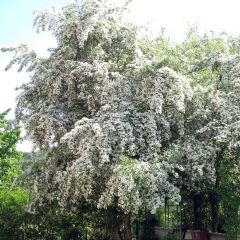
Crataegus monogyna - Hawthorn
- Flowering time May to July
- Height at maturity 7 m
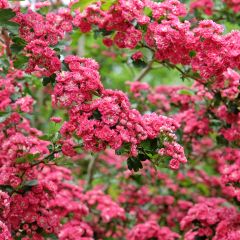
Crataegus laevigata Pauls Scarlet - Hawthorn
- Flowering time May to July
- Height at maturity 6 m
Discover other Hawthorn Crataegus
View all →Available in 1 sizes
Available in 1 sizes
Available in 1 sizes
Available in 3 sizes
Available in 1 sizes
Available in 3 sizes
Available in 1 sizes
Available in 1 sizes
Available in 1 sizes
Available in 1 sizes
How to plant hawthorn?
Planting a bare-root hawthorn
To plant a hawthorn from bare roots :
- Trim roots: cut dead ones and shorten any that are too long
- Dip roots in a pralin: a mixture of manure, soil and water
- Dig a trench or several holes large enough to spread the roots
- Place bushes and refill holes with excavated soil
- Water to avoid any air pockets
- Firm soil lightly around base of young bushes and mulch
Planting a hawthorn in a bucket or pot
- Soak buckets or containers in water for one hour to moisten the rootball
- Dig holes twice the volume of the rootball
- Remove bushes from pots and gently break up the rootball
- Add some well-rotted compost to bottom of hole
- Place bushes and refill holes with excavated soil
- Water well to remove any air pockets between soil and roots
- Firm soil at base of bushes and mulch
Planting hawthorn to create a defensive hedge
Plant hawthorns in two staggered ranks, spaced 30 cm apart. Cut trunks of young hawthorns to about 40 cm height so they ramify well from the start.

Hawthorns in situ: Crataegus monogyna / Crataegus laevigata ‘Paul’s Scarlet’ / hawthorn hedge
Read also
How to plant a hedge?How to propagate hawthorn?
Propagate hawthorn by sowing
This is the simplest and most effective method. In fact, birds often do the work for you. It is not uncommon to find young hawthorn shoots scattered around the garden. If, however, you wish to carry out the sowing yourself, you will need to wait at least through winter. Indeed, seed needs stratification to germinate.
You can sow hawthorn seeds :
- either directly in place: for this, dig a small hole in soil in autumn, place one or more haws and cover up. the following spring, you will see the first leaves of a young hawthorn.
- or in a pot: for this, in autumn, soak your haws in lukewarm water for 48 hours. Then place them, once softened, in a watertight container filled with sand. Keep this container all winter at about 10°C. At the start of spring, pot into a mix composed of one third garden soil, one third potting compost and one third sand. You can also place haws in the freezer for a week, then sow in pots to be left outdoors until spring.
Propagate hawthorn by graft
If you want to reproduce a specific variety, you can carry out a shield graft. This is not complicated, but generally produces an unsightly swelling at the point of graft. Take a common hawthorn (C. monogyna or C. laevigata for example) which will be the rootstock, make a slight T-shaped cut in the bark at the base of the trunk. Ease the bark slightly apart, then insert an eye of the variety to reproduce (the scion). This eye or bud is taken from the axil of a leaf or from a shoot. Secure everything in place with a raffia tie.
→ Learn more with our tutorial How to propagate hawthorn easily?
Hawthorn: how to care for, prune and treatOverviewHawthorn (Crataegus spp.) is a hardy, wildlife-friendly tree or shrub suited to hedges, small gardens and rural planting. Hardy and undemanding, hawthorn rewards minimal care with abundant spring blossom and autumn haws (fruit).Site and soil- Plant in full sun or partial shade. - Prefers well-drained soil, tolerates clay and chalky soils; neutral to slightly alkaline pH is ideal. - Avoid waterlogged sites; poor drainage can encourage root rot.Planting and watering- Plant bare-root or balled specimens during dormancy (late autumn to early spring). - Dig a planting hole slightly larger than rootball, backfill with existing soil, firm gently and mulch to retain moisture. - Water regularly during first growing season to help establish roots; once established, hawthorn is drought-tolerant.Feeding and mulch- Generally does not require heavy feeding. Apply a layer of well-rotted compost or garden compost in spring if soil is poor. - Mulch around base to conserve moisture and suppress weeds, keeping mulch away from trunk to avoid rot.Pruning (taille)- Best time for major pruning is late winter while tree is dormant, before bud burst. This reduces sap loss and helps wound closure. - Light pruning and shaping can be done after flowering in early summer to tidy growth without removing next year’s blossom. - Remove dead, diseased or crossing branches first. Make cuts just outside branch collar; avoid leaving stubs. - For size reduction, do it gradually over several seasons rather than heavy topping. Thinning cuts to open canopy improve light and air circulation. - For hedges: prune once or twice a year—trim in late summer after flowering and again in late winter for a neat shape. Hedge-laying or staggered trimming promotes dense growth.Tools and hygiene- Use sharp secateurs, loppers or a pruning saw for larger branches. Wear strong gloves and protective clothing because of hard thorns. - Sterilise tools between cuts when dealing with diseased wood to reduce spread of pathogens.Pests and diseases- Common issues: aphids, leaf spot, rusts and, occasionally, fire blight (bacterial). Monitoring and good sanitation help control problems. - Remove and burn heavily infected branches; dispose of fallen, diseased leaves. - Beneficial insects often keep aphid levels down; problem outbreaks can be treated with targeted, garden-approved controls. - Choose resistant varieties if fire blight is a local concern.Propagation- Propagate by seed (requires cold stratification and patience—seedlings may take several years to flower), by hardwood cuttings in winter or by grafting for named cultivars. Root suckers can be transplanted where present.Wildlife and seasonal notes- Flowers provide nectar and pollen for insects; haws are food for birds in autumn and winter. - Avoid heavy pruning during bird-nesting season (spring–early summer) to protect nesting wildlife. - Expect most flowering in spring; berries ripen in autumn and may persist into winter.Common mistakes to avoid- Heavy pruning in late autumn (can stimulate vulnerable new shoots). - Leaving stubs or making flush cuts that damage branch collars. - Neglecting tool hygiene when disease is present.With correct siting, basic pruning and simple hygiene, hawthorn remains a low-maintenance, valuable addition to garden and hedge planting.
Caring for hawthorn
Hawthorn needs very little care. Just remember to water during summer drought in the first year after planting.
Pruning hawthorn
Hawthorn tolerates pruning particularly well. That is why it is often used in many strictly clipped hedges.
Annual pruning of a formal hedge should always be carried out after flowering, that is around late June to early July. You will, admittedly, lose that year’s fruit, but you will not disturb flowering the following year. Hawthorn tolerates being cut back hard. When young, do not hesitate to prune severely at planting; this will help it to ramify.
To train a hawthorn as a tree, cut off low lateral branches and any suckers, and gradually raise the crown over the years to keep only a single trunk.
Finally, note that in an informal hedge or a slightly wild planting, you can quite as well leave your pruning shear in the shed and let hawthorn grow freely.
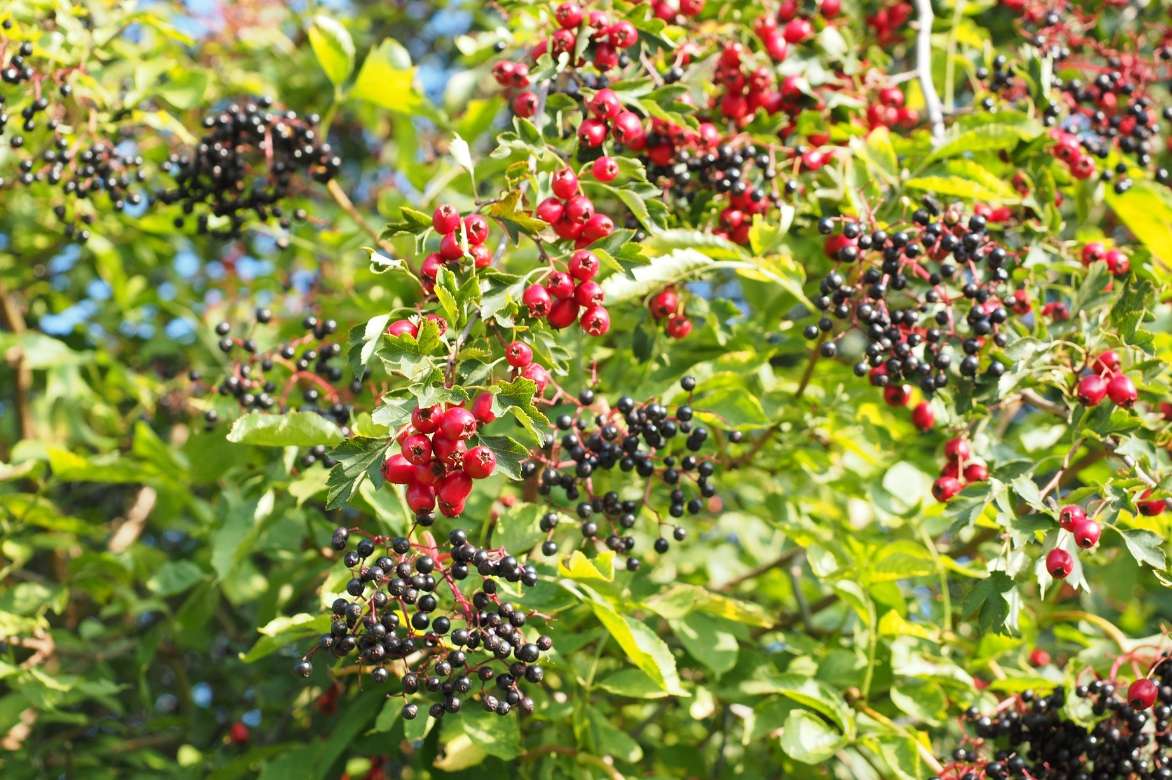
Red hawthorn haws accompanied by black elderberry berries
Possible diseases and pests of hawthorn
Hawthorn is a hardy small tree, but it sometimes suffers minor annoyances, often only cosmetic and very rarely dangerous for the tree.
- Entomosporiosis
This is a fungal disease that attacks certain trees in the Rosaceae family in wet conditions. The disease does not kill the tree but produces small unsightly grey spots on leaves. Remove affected leaves and cut out dead and dry shoots.
- Powdery mildew
Powdery mildew, or “white disease”, is also a fungal disease that affects almost all plants. A light white coating covers the leaves. No cause for alarm for hawthorn, however. To avoid it, space trees and shrubs adequately and avoid wetting foliage when it is very hot.
→ To find out more about this disease, consult our advice sheet : “Powdery mildew or white disease”
- Rust
Rust appears in warm, humid weather. It is recognised by large rust-coloured spots on leaves, which block part of photosynthesis and slightly weaken the tree. Remove the few affected leaves. A treatment with nettle manure or horsetail manure is generally effective.
- Fire blight
There was a time when the mere words “fire blight” inspired dread among nursery growers and fruit producers. This very contagious bacterial disease attacks mainly plants of the Rosaceae family in warm, humid weather: apples, pears, quince, cotoneaster, pyracantha, rowan and… hawthorn. Symptoms are very visible: black or rust-coloured spots appear on some leaves, whole shoots may suddenly blacken and wither, flowers and fruit turn brown-black and remain stuck to the tree as if burnt. The tree can succumb within a year.
No treatment is effective. You will have to cut out and burn everything that seems infected several centimetres below the infection and take care to disinfect your tools afterwards with alcohol. Sometimes complete removal of the tree or the whole hedge may be considered.
Fortunately, this disease is now almost a thing of the past. Nowadays species and varieties sold and grown are resistant to the disease (or grafted on a resistant rootstock). Those that were susceptible have been removed from commerce or cultivation (for example: pear ‘Passe-crassane’ in France). But vigilance remains necessary…
→ To find out more about this disease, consult our advice sheet : “Fire blight: identify and control this disease”
- Gall-forming aphids and other gall-inducing insects
Sometimes you may notice “strange” things on hawthorns: leaves suddenly forming a rosette at shoot tips, curling of certain other leaves or simply small pustules on the underside of leaves. This is not a disease, rest assured! It is simply the tree reacting to the bite of an insect or mite that has laid its eggs. This causes a gall or cecidium which is by no means harmful to your hawthorn.
Several insects and mites, notably tiny dipterans (gall midges), homopteran aphids (woolly aphids) and mites of the eriophyid family use hawthorn as their sole host plant (or nursery, one might say). As hawthorn is in no danger, there is no need to spray insecticidal products (even organic ones!) on your tree. Especially since a gall is such a resistant cocoon that spraying will achieve nothing, apart from killing everything around it. So let these little creatures live in peace and take a closer interest in the fascinating science of galls: cecidology.
please note : “gall-forming” and “gall-inducing” are synonyms. Both words simply mean “produce galls”.
→ Learn more about hawthorn diseases and pests in our advice sheet
How to combine and use hawthorn?
Pairing hawthorns in a trimmed, defensive hedge
What better way to protect privacy and peace than a hedge that pricks, scratches, bruises and tears! If you plant white thorns, flanked by Pyracantha, Holly and Berberis julianae and take care to prune your hedge regularly to thicken it, not even a cat will get through. In addition, it will be attractive all year thanks to evergreens among them, numerous colourful fruits in autumn and hawthorn’s magnificent white flowering in May.

An example of a defensive hedge combination: Crataegus monogyna, Ilex aquifolium, Pyracantha ‘Orange Glow’ and Berberis julianae
Pairing hawthorns in an informal, wildlife-friendly hedge
If you want to combine beauty of a slightly wild flowering hedge with helping nature, hawthorn is clearly a must-have. Equally valuable are blackthorns, Guelder rose, black elder, dogwood and hazels. Leave these bushes free from systematic pruning. They will provide shelter and food for all wildlife in your garden while remaining very attractive year-round with their flowering, fruiting, autumn foliage and colourful stems in winter.

An example of an ecological hedge combination: Crataegus monogyna, Prunus spinosa, Sambucus nigra and Viburnum opulus
Pairing hawthorns in a shrub border
Fancy a pretty little shrub border with spring flowering? Try Crataegus laevigata ‘Paul’s Scarlet’, which will flower in May in an explosion of deep pink double flowers, alongside a beauty bush and an Viburnum of Prague with evergreen foliage. To extend flowering into mid-summer, add a Deutzia with pink and white flowers and a Buddleia alternifolia with melliferous pink-lilac flowering. This little border, so dazzling in spring and early summer, might look a little dull in winter unless you add a small blue spruce, which will companion your bushes with its lovely bluish needles all year. As groundcover, try a tapetum of Cornus sericea ‘Kelseyi’, a dogwood with decorative wood that only reaches about 75 cm and will delight you with charming autumn foliage and colourful stems through winter.
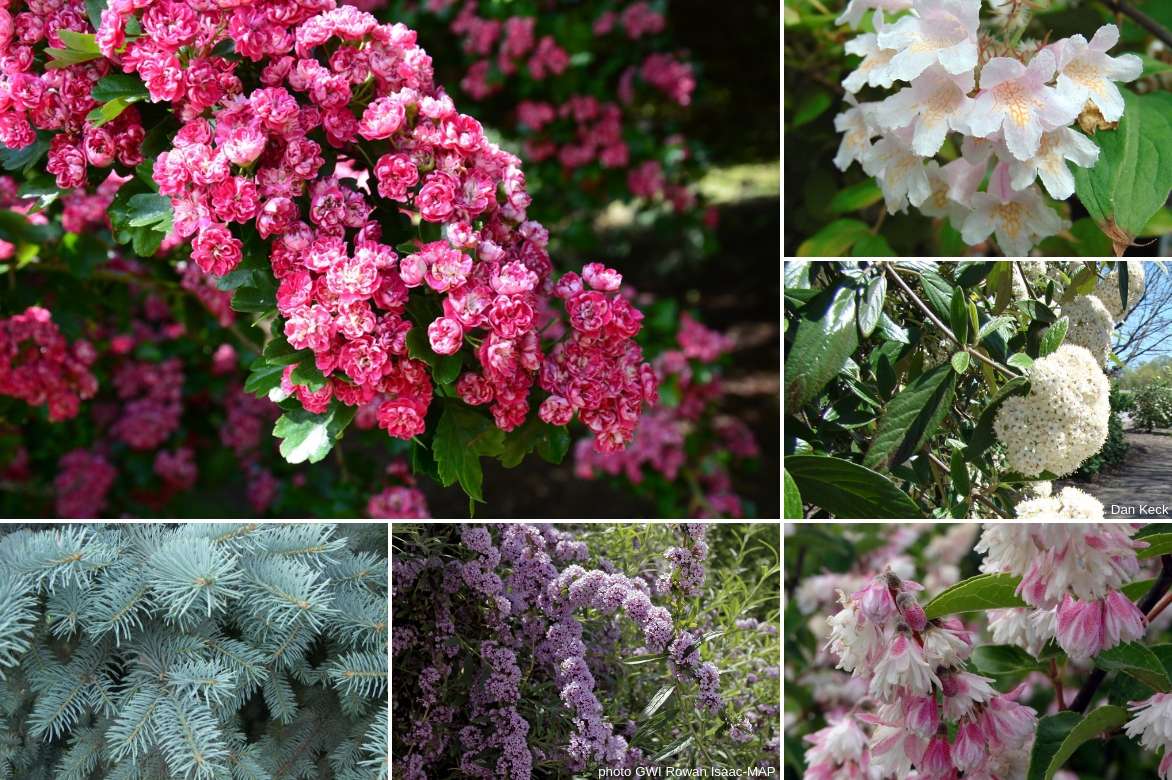
An idea for a border combination: Crataegus laevigata ‘Paul’s Scarlet’, Kolkwitzia amabilis, Viburnum pragense, Deutzia scabra ‘Plena’, Buddleia alternifolia and Picea pungens ‘Glauca Globosa’
Please note: hawthorns make cute little bonsai ideal for beginners. These small trees soon develop mature bark, tolerate repeated pruning very well and ramify well. In addition, miniature size of flowers and fruits makes bonsai look very natural.
→ More pairing ideas with hawthorn in our sheet: How to pair hawthorns
Useless anecdotes about hawthorns
- Formerly, chopping blocks were made from hawthorn wood
- Hard hawthorn wood was used to make barrels or small mechanical parts
- Marseille fishermen used to place a hawthorn branch at the masthead, which they believed brought them the luck of a miraculous catch
- Hawthorns are symbols of fidelity, chastity and celibacy
- Countless legends surround these small trees, which are said to repel lightning, snakes and sorcerers. (I have many hawthorns at home and very few sorcerers knock at my door. See — it works!)
- The director of the DeLorean car factory had decided, against his workers’ advice, to uproot an ancient hawthorn reputed to shelter fairies. He went bankrupt the following year… (well, in truth it was mostly due to poor management and ugly, badly designed cars… But it’s a nice story)
“Hawthorn, my dear,
I pick you and I take you.
If I die on the way,
Serve me as sacrament. “
Recipe for hawthorn fruit jam
Recipe for hawthorn haws and raspberry jam
- Remove seeds from 2 kg of hawthorn haws Craetegus monogyna with a fork (easier because this species has only one large seed) ;
- Cook them in a little water until they can be mashed with a fork ;
- Pass through a sieve then add raspberries (about 500 g) ;
- Weigh everything and add 3 parts sugar to 4 parts fruit (for example: for 2 kg of fruit, that will be only 1.5 kg of sugar) ;
- Cook over high heat for about fifteen minutes, stirring constantly with a wooden spoon ;
- From time to time, drop a little onto a cold saucer to see if jam sets ;
- As soon as it does, remove from heat and pour into jam jars sterilised with steam (with sealing system) ;
- Close jars, invert and leave to cool.
Useful resources
Discover our hawthorns at the nursery.
Our advice sheets :
- How to pair hawthorns?
- Choosing the right hawthorn for the garden
- Essential hawthorns with white flowers for the garden
- Discover hawthorns with pink and red flowers
- When and how to plant a hawthorn hedge?
- How to prune a hawthorn?
- and our tutorial : How to make hawthorn tea?
Frequently asked questions
-
Is fire blight still a threat?
Let's say it's important to be cautious and watch for the slightest symptoms. Nowadays, this disease is much less common in our gardens and crops. This is because susceptible varieties were uprooted and permanently withdrawn from sale, leaving room only for resistant varieties.
-
On my hawthorns, leaves form rosettes at shoot tips. What disease is this?
This is not a disease but a reaction of your hawthorns following the sting of a tiny dipteran named Dasineura crataegi: this is called a gall or cecidium. It frequently occurs in pruned hawthorn hedges. Although this phenomenon may look alarming, it is entirely harmless to your bushes and there is no need to worry.
-
I've received a small hawthorn bush but I'd like it to shoot up into a tree. How can I do that?
Examine your tree to identify strongest stem of your shrub and cut other branches when planting. Later, when your standard has grown, you can prune some low lateral branches to raise crown slightly. Also remove any basal shoots.
- Subscribe!
- Contents
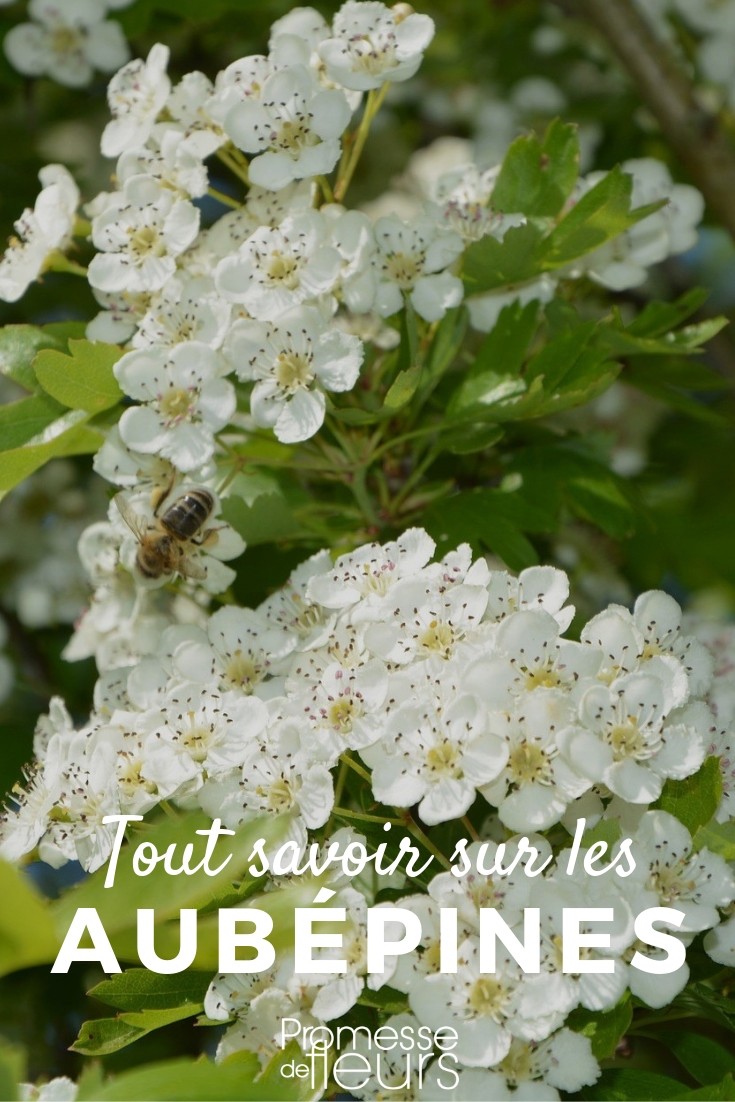































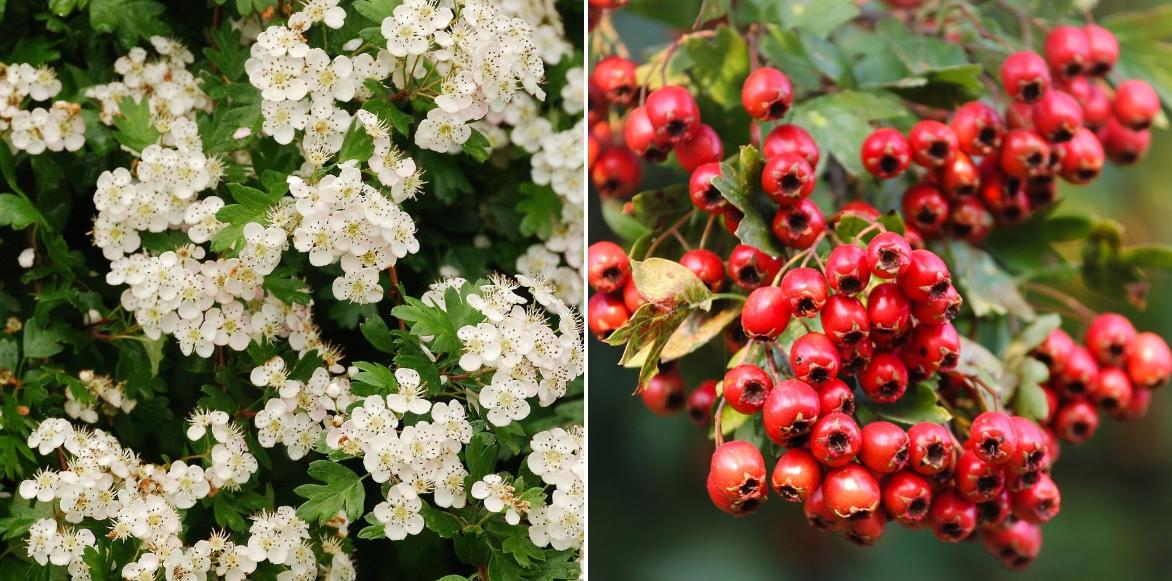
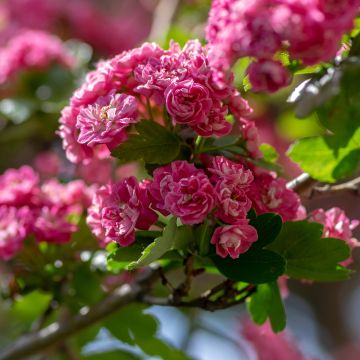
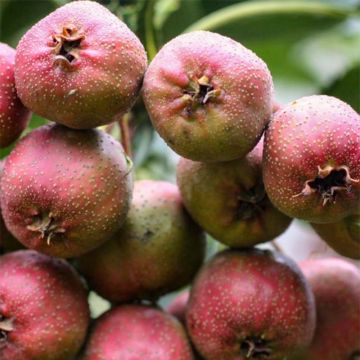
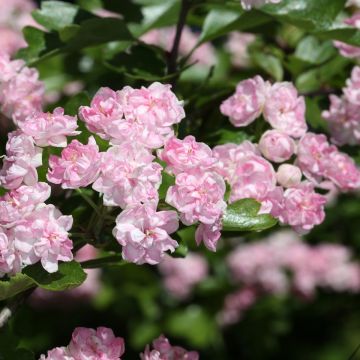



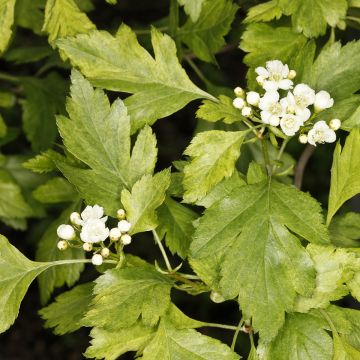
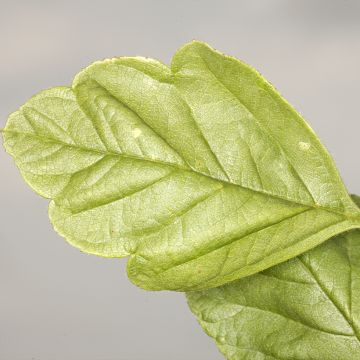
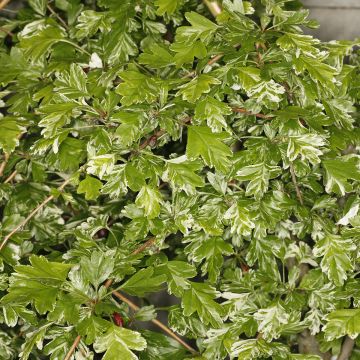

Comments